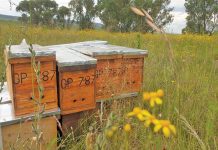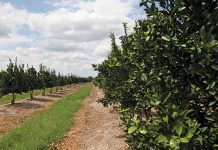The Orange River Valley is the largest wine-producing region in South Africa in terms of volume, but it’s battling perceptions and prejudices. A local co-op is now fighting for recognition of the region and its quality wines. Glenneis Erasmus reports.
Oranjerivier Wine Cellars Co-op Ltd was established in the Northern Cape in 1965 and today it’s the largest winery in the southern hemisphere. The total intake from the member cellars has grown from an initial 5 182 to over 180 000t, with a major expansion in the 1970s to Keimoes, Grootdrink, Groblershoop and Kakamas, as well as a grape juice facility at Kanoneiland.
Matthee van Schalkwyk, production and planning manager who also helped build some of these cellars, explains the expansion meant farmers would only supply wineries in their areas. This rule still applies today – farmers have to trade shares where they want to supply grapes to increase their production quotas.
Onslaught of the purists
However, the region has become stigmatised as a producer of inferior wines. Koos Visser, marketing manager of Oranjerivier Wine Cellars explains it’s long been the stepchild of the wine industry due to the incorrect perceptions of industry roleplayers. Wines of South Africa (Wosa), which is supposed to represent the whole South African wine industry, only recently incorporated the region on its official map. He feels the region’s been purposefully excluded from big marketing events and alleges that some wine judges are prejudiced against Oranjerivier Wine Cellars wines before they’ve even tasted them.
“We know of more than one incident where our wines were judged low under our brand name, but they received an above-average grade under one of our client’s brands. Yet the wine in the bottles was exactly the same.” So why all this resistance? Firstly, there are those who believe a good wine can only be produced in close proximity to the sea. And these “purists” will hold onto this belief even if their taste buds or noses beg to differ.
Henning Burger, viticulturist of Oranjerivier Wine Cellars, says this belief is absolute nonsense. He points out there are many vineyards, especially around Keimoes and Upington, completely surrounded by water. “The cooling effect of the water on these islands in the Orange River is similar to what is experienced at vineyards close to the sea,” he explains.
The ins and outs of the soil
Another challenge for the region is the association of quality wine with low-volume production. “This perception is also flawed as it disregards the impact of soil fertility on production,” Henning says. “A producer with poor quality soil, in Stellenbosch for example, might only be able to produce 8t of grapes per hectare. Producing more grapes would compromise the quality of the end-product.”
The Orange River wine-producing region has deep loamy soil containing more than 50% silt, and is situated next to the Orange River and its canals – the locals refer to this fertile soil as binnegrond. Vineyards there can easily produce up to 40t of wine grapes per hectare without any negative impact on quality. Production averages around 35t/ha in the binnegrond.
“Producing fewer grapes to manipulate quality as is prescribed in some of the other wine-producing areas would be a waste of good grapes on the binnegrond,” Henning says. Soil a little further away from the river called buitegrond usually requires more focus on fertilisation and soil preparation. Production is lower and more expensive inputs, like fertiliser and irrigation, are necessary than on the binnegrond where flood irrigation is primarily used. As water quotas are limited, farmers are starting to use more efficient irrigation methods.Wine quality is rooted in soil fertility as well as the leaf surface to the soil surface ratio, according to Henning.
Farmers in the region therefore make use of elaborate trellises like the T and gable systems, almost like the table grape producers, to increase leaf surface areas. The horizontal bar of the T-trellis is 1,2m long on average, but some farmers use a horizontal bar of up to 1,5m. Most of the farmers in the region use cover crops as mulch to increase soil carbon levels to serve as nutrition for soil microbes. Farmers on the buitegrond use legumes because of their ability to fix nitrogen from the atmosphere. This is not necessary on the binnegrond where non-legume crops are used. The cover crops also improve soil water retention.
Labour headaches
Henning says a shortage of labour in the region could result in producers being unable to get their grapes in time. Many farmers are already converting to mechanisation. The co-op is also in the process of importing a harvesting machine that can be used on T-trellises. “The advantage of having the grapes harvested quickly far outweighs the benefits of having the grapes on the stalks for longer,” Henning explains.
Many advantages
A huge advantage of the co-op is that it sources wine grapes from 831 producers over a diverse terroir of 4 500ha, extending from Groblershoop to Blouputs along both sides of the Orange River. In addition, each cellar has its own winemakers with their unique skills. “The result is a huge variety of wines, which can be blended into a consistently high-quality end-product,” says Visser. “But areas producing a lower volume of wine have less control and selection choice to manipulate the final product.”
The close proximity of cellars to the vineyards is another advantage. Van Schalkwyk explains grapes lose flavour if left in the sun for too long.
Most cellars are therefore positioned within a 30km radius of the vineyards which supply them, so the grapes can be delivered to the cellars the same day they’re harvested.
Visser points out they haven’t experienced problems with surplus wines as is the case with some other cellars in South Africa. He attributes this to the strong marketing strategy of the co-op. “We have a market for every wine produced at the cellars and we don’t expand production unless we have a market for the additional volume.”
Marketing to promote wine quality
The cellars have embarked on a huge marketing campaign to promote the region as one of South Africa’s top wine-producing regions. And Oranjerivier Wine Cellars has already proved itself by winning various awards over the past few years, despite all the challenges.
“We’re not aspiring to become premium or boutique wines. We want to find a balance between good quality and affordability for our clients, balanced with realistic margins for our producers,” Matthee says. He adds that the co-op has been employing viticulturists to already manipulate wine quality in the vineyard. This is a long-term strategy, the effects of which can already be seen in the quality of the cellars’ wines. The viticulturists also provide producers with advice on which cultivars to plant, soil preparation and vineyard management.
Visser says they don’t chase wine fads, but prefer to identify which cultivars work best in which areas and then seek markets for them. Contact Oranjerivier Wine Cellars
on (054) 337 8800 or visit
www.orangeriverwines.com. |fw








